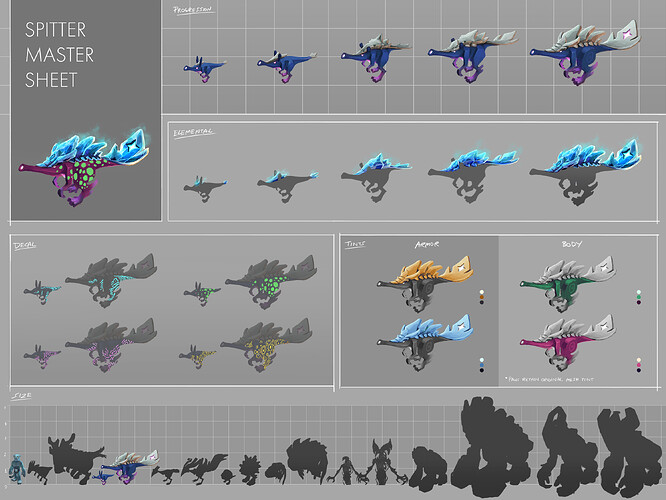Spitter Master Sheet
Key Visual Features:
- Ranged Creature (Shoots Projectiles)
- Classic Progression\Power (5 tiers)
- Elemental Progression
- Exotic Progression
Spitter General Description:
The Spitter is a common, ranged attack creature found on many worlds particularly the lower threat ones. One of it’s key indentity traits is that it never walks but instead runs around the world from place to place. It’s personality resembles an cautious but also aggressive armadillo scurrying around and dodging to avoid being hit back. When in an agitated state they shoot projectiles at nearby enemies, and strafe around their target. They can be often found alone or in groups.
Introducing Species Progression and Classic Progression
Today, this post will focus on our visual approach to creature progression and in particular why we think the Wildstock is better suited towards a ‘Species Progression’ and why the Spitter adopts a more conventional ‘Classic Progression’.
This will hopefully explain the deciding factors on how the art team creates the visual progression a creature will have, which closely ties the aesthetics into it’s identity, behaviour and gameplay functionality.
So in a ‘nutshell’, any one of our creatures can have up to 5 tiers of visual mesh change to represent it’s ‘Difficulty’ and ‘Power’ in the gameplay design.
For example:
A peaceful easy-going world will have more creatures suited to that game play environment. Alternatively a more challenging combat environment may sport the more powerful and difficult creatures.
- The challenge is that ‘not one solution will fit every creature aesthetically’ or even make sense visually.
After a lot of visual exploration, we identified two clear categories that our family of Boundless creatures can relate and be placed into. We labelled these as Species Progression and Classic Progression.
Species Progression
The Wildstock is a perfect example to why a Species Progression was needed visually for the best considered artistic approach.
So we needed to represent the 5 visual tiers of ‘Power/Difficulty’ in gameplay whilst still maintaining the same rig\ai and animations. Done in the Classic Progression way, you would end up with just so many, many, many ‘goat-like-creatures’ and since this creature is found in large groups\herds and has random behaviour we had to consider another visual approach of achieving what we needed.
For the Wildstock we felt that the herds should look like they are part of the same family - like a pack of Lions, Zebras or Elephants. By having each tier looking like a unique species, this also allows us future scope to have unlimited tiers if we so choose to make more Wildstock later down the line.
The gameplay for this creature is key here because IN this herd of creatures part of the joy is that any random creature may react more aggressively than the others! This behaviour resembles and connects to it’s nature in reality… for example what would happen if you attack a herd of Moose, Cattle or Gazelles?
As ambient creatures with reactive behaviours that are utterly random - part of the surprise will be when one of the pack reacts in a more angry fashion than the others…same for those running scared. ![]()
This visual approach according to the above example is particularly appealing when considering what a level 1 Wildstock may look like in comparison with the most aggressive level 5 in terms of the gameplay. Our visual concepts and design reflect the behaviours of ‘most vulnerable and therefore weakest’ to the ‘most aggressive and therefore dangerous’.
Classic Progression
The Spitter we feel is definitely suited toward the Classic Progression, deriving from being a ranged creature with a strong string of solo behaviours as part of the AI.
Our level 1 Spitter clearly visually shows it’s the weakest in terms of power and level 5 is the strongest and therefore has the fiercest combat.
Incidentally, that’s not to say we can’t have another species of Spitter later on… but that new species will also have similar tiers of strength to represent it’s gameplay in the conventional way and to keep the game consistent.
As I mentioned before, we aim to create a visual common language for all the creature of Boundless.
-
If the creature generally has ‘Group behaviour’ like the ‘Wildstock’ (and in the future, possibly also the ‘Fast Flyer’) then we create a visual treatment for Species Progression that’s specifically good for adding a lot of variety of life as part of the world ambience.
-
If the creature has a bespoke and unique ‘Solo Behaviour’ then the levels of combat and core gameplay is of the most importance to this creature and is therefore the primary visual focus.
We feel overall, that both Species and Classic progression visibly show ‘power and difficulty’ in gameplay clearly while being sensitive to it’s identity/personality and behaviour.

 Can’t wait to see these in game!
Can’t wait to see these in game!